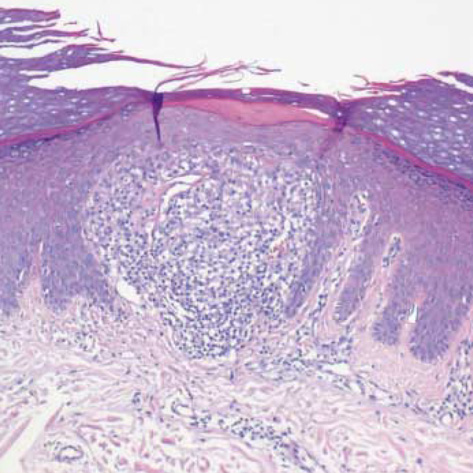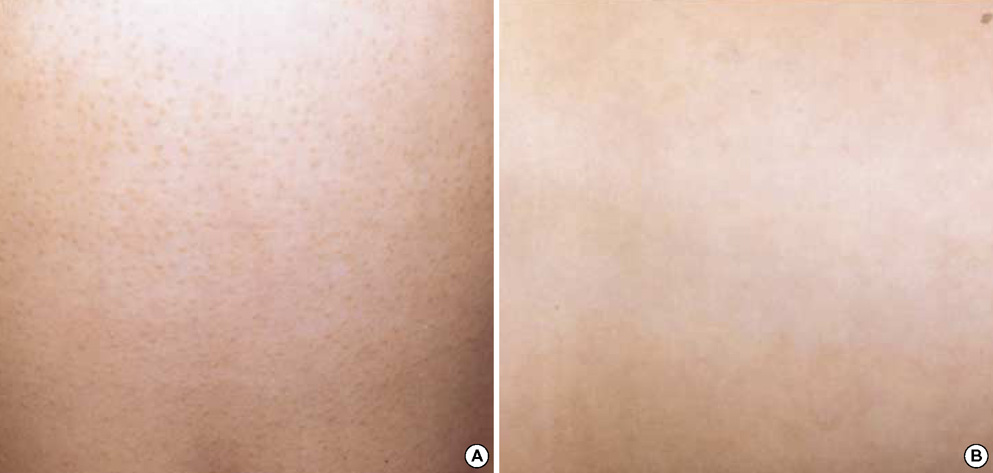J Korean Med Sci.
2007 Feb;22(1):163-166. 10.3346/jkms.2007.22.1.163.
Generalized Lichen Nitidus Successfully Treated with Narrow-band UVB Phototherapy: Two Cases Report
- Affiliations
-
- 1Department of Dermatology, College of Medicine, Ewha Womans University, Seoul, Korea. uwon313@ewha.ac.kr
- KMID: 1713260
- DOI: http://doi.org/10.3346/jkms.2007.22.1.163
Abstract
- Lichen nitidus (LN) is an uncommon chronic inflammatory skin disease composed of numerous, tiny, shiny, flesh-colored papules that are predominantly observed on the chest, abdomen, glans penis and upper extremities. The distribution of LN is most often localized, but in some cases it can become generalized. Because LN tends to be asymptomatic and presents spontaneous resolution within several years, it usually does not require treatment except in symptomatic, persistent and generalized cases. We describe a 28-yr-old man and a 7-yr-old boy with generalized LN where both cases improved with narrow-band ultraviolet B (NB-UVB) phototherapy plus topical steroid ointment. Both patients noted improvement within the first three treatments and showed almost complete resolution after 18 and 20 treatments, respectively. NB-UVB phototherapy may be an effective alternative therapy for the treatment of generalized LN, even for those patients in their childhood.
Keyword
MeSH Terms
Figure
Reference
-
1. Lapins NA, Willoughby C, Helwig EB. Lichen nitidus: A study of forty-three cases. Cutis. 1978. 21:634–637.2. Randle HW, Sander HM. Treatment of generalized lichen nitidus with PUVA. Int J Dermatol. 1986. 25:330–331.
Article3. Chen W, Schramm M, Zouboulis CC. Generalized lichen nitidus. J Am Acad Dermatol. 1997. 36:630–631.
Article4. Lee SD, Kim MY, Baek SC, Houh D, Byun DG. Two cases of lichen nitidus treated with diphenylcyclopropenone immunotherapy. Korean J Dermatol. 2001. 39:1432–1434.5. Ocampo J, Torne R. Generalized lichen nitidus -report of two cases treated with astemizole. Int J Dermatol. 1989. 28:49–51.6. Libow LF, Coots NV. Treatment of lichen planus and lichen nitidus with itraconazole. Cutis. 1998. 62:247–248.7. Kubota Y, Kiryu H, Nakayama J. Generalized lichen nitidus successfully treated with an antituberculous agent. Br J Dermatol. 2002. 146:1081–1083.
Article8. Lucker GP, Koopman RJ, Steijlen PM, Valk PG. Treatment of palmoplantar lichen nitidus with acitretin. Br J Dermatol. 1994. 130:791–793.
Article9. El-Ghorr AA, Norval M. Biological effects of narrow-band (311nm TL01) UVB irradiation. a review. J Photochem Photobiol B. 1997. 38:99–106.
- Full Text Links
- Actions
-
Cited
- CITED
-
- Close
- Share
- Similar articles
-
- A Clinical Study of Generalized Lichen Nitidus
- Narrow-Band UVB Phototherapy in Korean Psoriasis Patients
- Efficacy of Narrow-Band UVB Phototherapy in Vitiligo Patients
- A Case of Generalized Lichen Nitidus That Developed after a Subcutaneous Insulin Injection in a Patient with Diabetes Mellitus
- A Case of Generalized Lichen Nitidus Treated with Low Dose Cyclosporine




